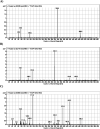Sapitinib: reactive intermediates and bioactivation pathways characterized by LC-MS/MS
- PMID: 35529145
- PMCID: PMC9073192
- DOI: 10.1039/c9ra03926k
Sapitinib: reactive intermediates and bioactivation pathways characterized by LC-MS/MS
Abstract
Sapitinib (AZD8931, SAP) is an epidermal growth factor receptor (EGFR) family (pan-erbB) tyrosine kinase inhibitor. In multiple tumor cell lines, SAP has been shown to be a much more potent inhibitor of EGF-driven cellular proliferation than gefitinib. In this in vitro metabolic study, we tested the generation of reactive intermediates from SAP using human liver microsomes and a capturing agent (potassium cyanide) to trap the iminium reactive intermediates. The same metabolic reaction was further repeated in the presence of methoxyamine to trap aldehyde intermediates. The identification of SAP metabolites revealed that the hydroxylation metabolic reaction represents the major in vitro metabolic pathway occurring at the piperidine moiety. We characterized six in vitro phase I metabolites in addition to three reactive intermediates (i.e., two iminiums and one aldehyde), therefore suggesting two probable SAP-bioactivation pathways. We hypothesized that the piperidine ring nitrogen (cyclic tertiary amine) activated the two adjacent α-carbons within the ring. The oxidative dealkylation of the N-acetamide group led to an unstable aldehyde that was trapped using methoxyamine, generating an oxime adduct that was detected using liquid chromatography-tandem mass spectrometry (LC-MS/MS). To the best of our knowledge, this is the first study presenting the structural characterization of SAP reactive intermediates.
This journal is © The Royal Society of Chemistry.
Conflict of interest statement
None.
Figures





















Similar articles
-
Investigation of Fenebrutinib Metabolism and Bioactivation Using MS3 Methodology in Ion Trap LC/MS.Molecules. 2023 May 22;28(10):4225. doi: 10.3390/molecules28104225. Molecules. 2023. PMID: 37241965 Free PMC article.
-
Characterization of reactive intermediates formation in dacomitinib metabolism and bioactivation pathways elucidation by LC-MS/MS: in vitro phase I metabolic investigation.RSC Adv. 2018 Nov 19;8(68):38733-38744. doi: 10.1039/c8ra06709k. eCollection 2018 Nov 16. RSC Adv. 2018. PMID: 35558335 Free PMC article.
-
Belizatinib: Novel reactive intermediates and bioactivation pathways characterized by LC-MS/MS.J Pharm Biomed Anal. 2019 Jul 15;171:132-147. doi: 10.1016/j.jpba.2019.04.006. Epub 2019 Apr 6. J Pharm Biomed Anal. 2019. PMID: 30999224
-
Role of cyclic tertiary amine bioactivation to reactive iminium species: structure toxicity relationship.Curr Drug Metab. 2011 Jan;12(1):35-50. doi: 10.2174/138920011794520044. Curr Drug Metab. 2011. PMID: 21222587 Review.
-
Biotransformation and bioactivation reactions of alicyclic amines in drug molecules.Drug Metab Rev. 2014 Aug;46(3):379-419. doi: 10.3109/03602532.2014.924962. Epub 2014 Jun 9. Drug Metab Rev. 2014. PMID: 24909234 Review.
Cited by
-
Targeting HER2 in Gastroesophageal Adenocarcinoma: Molecular Features and Updates in Clinical Practice.Int J Mol Sci. 2024 Mar 30;25(7):3876. doi: 10.3390/ijms25073876. Int J Mol Sci. 2024. PMID: 38612688 Free PMC article. Review.
-
Identification of Iminium Intermediates Generation in the Metabolism of Tepotinib Using LC-MS/MS: In Silico and Practical Approaches to Bioactivation Pathway Elucidation.Molecules. 2020 Oct 28;25(21):5004. doi: 10.3390/molecules25215004. Molecules. 2020. PMID: 33126762 Free PMC article.
-
Development of an LC-MS/MS Method for Quantification of Sapitinib in Human Liver Microsomes: In Silico and In Vitro Metabolic Stability Evaluation.Molecules. 2023 Mar 2;28(5):2322. doi: 10.3390/molecules28052322. Molecules. 2023. PMID: 36903565 Free PMC article.
References
LinkOut - more resources
Full Text Sources
Research Materials
Miscellaneous

